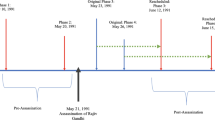Abstract
This paper focuses on the observed empirical relationship between fiscal rules and budget deficits, and examines whether this correlation is driven by an omitted variable, namely voter preferences. We make use of two different estimation methods to capture voter preferences in a panel of Swiss sub-federal jurisdictions. First, we include a recently constructed measure of fiscal preferences. Second, we capture preferences through fixed effects with a structural break as women are enfranchised. We find that fiscal rules continue to have a significant impact on real budget balances.
Similar content being viewed by others
References
Alesina, A., & Bayoumi, T. (1996). The costs and benefits of fiscal rules: evidence from U.S. states (NBER Working Paper 5614).
Alesina, A., Roubini, N., & Cohen, G. (1999). Political cycles and the macroeconomy. Cambridge: MIT Press.
Alt, J., & Lowry, R. (1994). Divided government, fiscal institutions, and budget deficits: evidence from the States. American Political Science Review, 88, 811–828.
Barro, R. (1979). On the determination of public debt. Journal of Political Economy, 87, 940–971.
Bohn, H., & Inman, R. (1996). Balanced-budget rules and public deficits: evidence from the U.S. states. Carnegie-Rochester Conference Series on Public Policy, 45, 13–76.
Buchanan, J. (1964). Public debt, cost theory and the fiscal illusion. In J. Ferguson (Ed.), Public debt and future generations. Chapel Hill: University of North Carolina Press.
Carare, A., Khamis, M., & Debrun, X. (2006). Switzerland: selected issues (IMF Country Report 06/203).
Dafflon, B., & Pujol, F. (2001). Fiscal preferences and fiscal performance: Swiss cantonal evidence. International Public Management Review, 2, 54–76.
Feld, L., & Kirchgässner, G. (2001). Does direct democracy reduce public debt? Evidence from Swiss municipalities. Public Choice, 109, 347–370.
Feld, L., & Kirchgässner, G. (2006). On the effectiveness of debt brakes: the Swiss experience (CREMA Working Paper 2006/21).
Feld, L., & Matsusaka, J. (2003). Budget referendums and government spending: evidence from Swiss cantons. Journal of Public Economics, 87, 2703–2724.
Funk, P., & Gathmann, C. (2005). What women want: suffrage, female voter preferences and the scope of government. Unpublished manuscript.
Funk, P., & Gathmann, C. (2006). Estimating the effect of direct democracy on policy outcomes: preferences matter. Unpublished manuscript.
Gorman, W. (1980). A possible procedure for analysing quality differentials in the egg market. Review of Economic Studies, 47, 843–856.
Heckman, J., & Snyder, J. (1997). Linear probability models of the demand for attributes with an empirical application to estimating the preferences of legislators. RAND Journal of Economics, 28, S142–S189.
Hibbs, D. (1977). Political parties and macroeconomic policy. American Political Science Review, 7, 1467–1487.
Krogstrup, S., & Wälti, S. (2007). Women and budget deficits (HEI Working Paper 13/2007).
Krogstrup, S., & Wyplosz, C. (2007). Dealing with the deficit bias: principles and policies. Unpublished manuscript.
Lagona, F., & Padovano, F. (2007). A nonlinear principal components analysis of the relationship between budget rules and fiscal performance in the European Union. Public Choice, 130, 401–436.
Lancaster, K. (1966). A new approach to consumer theory. Journal of Political Economy, 74, 132–157.
Lott, J., & Kenny, L. (1999). Did women’s suffrage change the size and scope of government. Journal of Political Economy, 107, 1163–1198.
Persson, T., & Svensson, L. (1989). Why a stubborn conservative would run a deficit: policy with time-inconsistent preferences. Quarterly Journal of Economics, 104, 325–345.
Persson, T., & Tabellini, G. (2000). Political economics, explaining economic policy. Cambridge: MIT Press.
Plümper, T., & Troeger, V. (2007). Efficient estimation of time-invariant and rarely changing variables in finite sample panel analyses with unit fixed effects. Political Analysis, 15, 124–139.
Poterba, J. (1994). State responses to fiscal crises: the effects of budgetary institutions and politics. Journal of Political Economy, 102, 799–821.
Poterba, J. (1996). Budget institutions and fiscal policy in the U.S. states. American Economic Review, 86, 395–400.
Schaltegger, C. (2002). Budgetregeln und ihre Wirkung auf die öffentliche Haushalte: empirische Ergebnisse aus den US-Bundesstaaten und den Schweizer Kantonen. Schmollers Jahrbuch, 122, 369–413.
Stutzer, A., & Kienast, L. (2005). Demokratische Beteiligung und Staatsausgaben: die Auswirkungen des Frauenstimmrechts. Swiss Journal of Economics and Statistics, 141, 617–650.
Tellier, G., & Imbeau, L. (2004). Budget deficits and surpluses in the Canadian provinces: a pooled analysis. Unpublished manuscript.
Weingast, B., Shepsle, K., & Johnsen, C. (1981). The political economy of benefits and costs: a neoclassical approach to distributive politics. Journal of Political Economy, 89, 642–664.
Author information
Authors and Affiliations
Corresponding author
Additional information
Most of the work on this paper was carried out while Krogstrup was at The Graduate Institute of International Studies, Geneva, Switzerland, and while Wälti was at the Department of Economics, Trinity College Dublin, Ireland. We are grateful to two anonymous referees and the Editor for insightful comments and suggestions. Our thanks also extend to Patricia Funk, Alois Stutzer, Lukas Kienast, Eva May, Christophe Matthey, Madeleine Schneider, and Elisabeth Aebischer for providing data. The views expressed in this paper are those of the authors and do not necessarily represent those of the Swiss National Bank.
Rights and permissions
About this article
Cite this article
Krogstrup, S., Wälti, S. Do fiscal rules cause budgetary outcomes?. Public Choice 136, 123–138 (2008). https://doi.org/10.1007/s11127-008-9285-y
Received:
Accepted:
Published:
Issue Date:
DOI: https://doi.org/10.1007/s11127-008-9285-y




